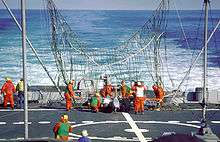AAI RQ-2 Pioneer
| RQ-2 Pioneer | |
|---|---|
 | |
| RQ-2 Pioneer over Iraq | |
| Role | Reconnaissance UAV |
| National origin | Israel/United States |
| Manufacturer | AAI Corporation, Israel Aircraft Industries |
| Introduction | 1986 |
| Retired | 2007 |
| Number built | 175 delivered; 35 in service |
| Developed into | AAI RQ-7 Shadow |
The AAI RQ-2 Pioneer is an unmanned aerial vehicle (UAV) that had been utilized by the United States Navy, Marine Corps, and Army, and deployed at sea and on land from 1986 until 2007. Initially tested aboard USS Iowa, the RQ-2 Pioneer was placed aboard Iowa-class battleships to provide gunnery spotting, its mission evolving into reconnaissance and surveillance, primarily for amphibious forces.
It was developed jointly by AAI Corporation and Israel Aircraft Industries. The program grew out of successful testing and field operation of the Tadiran Mastiff UAV by the American and Israeli militaries.[1]
Essentially, the Pioneer is an upgraded Tadiran Mastiff which was re-engined to accommodate a greater payload by request of the US Navy. To accomplish this, the original "Limbach" two-cylinder two-stroke engine was replaced with a Fichtel & Sachs two-cylinder two-stroke. The Limbach motor utilized a 71 cm propeller from Propeller Engineering and Duplicating, Inc. of San Clemente, California. The newer, more powerful Fichtel & Sachs motor was outfitted with a 74 cm propeller (which spins in the opposite direction) from the Sensenich Propeller Manufacturing Company of Lancaster, Pennsylvania.
Operation


Launched by rocket assist (shipboard), by catapult, or from a runway, the Pioneer recovers into a net (shipboard) or with arresting gear after flying up to five hours with a 75-pound (34 kg) payload. It flies day or night missions with a gimbaled EO/IR sensor, relaying analog video in real time via a C-band line-of-sight (LOS) data link. Since 1991, Pioneer has flown reconnaissance missions during the Persian Gulf, Somalia (UNOSOM II), Bosnia, Kosovo and Iraq conflicts. In 2005, the Navy operated two Pioneer systems (one for training) and the Marines operated two, each with five or more aircraft. It is also operated by Israel and the Republic of Singapore Air Force. In 2007 Pioneer was retired by the US Navy and was replaced by the Shadow UAV.
Internationally, Pioneer drones are perhaps most remembered for their role in the 1991 Gulf War, when a Pioneer launched by the Iowa-class battleship USS Wisconsin (BB-64) observed Iraqi troops on Failaka Island surrendering shortly after USS Missouri's attack on their trenchlines. When navy officials offered to transfer a Pioneer to the Smithsonian Institution, curators at the National Air and Space Museum specifically asked for the UAV that Iraqi troops surrendered to during the Gulf War.[2]
The "R" is the Department of Defense designation for reconnaissance; "Q" means unmanned aircraft system. The "2" refers to its being the second of a series of purpose-built unmanned reconnaissance aircraft systems.
Specifications
- Primary Function: Artillery Targeting and Acquisition, Control of Close Air Support, Reconnaissance and Surveillance, Battle Damage Assessment, Search and Rescue, Psychological Operations
- Contractor: Pioneer UAVs, Incorporated; Israel Aerospace Industries Ltd.
- Power Plant: Sachs 2-stroke 2-cylinder horizontally-opposed piston engine rated at 26 hp (19 kW) or alternative RQ-2C: UEL AR-741 rotary engine; 28.3 kW (38 hp)
.png)
- Length: 14 feet (4 m)
- Height: 3.3 feet (1.0 m)
- Weight: 205 kg (452 pounds)
- Wingspan: 16.9 feet (5.2 m)
- Speed: 110 knots (200 km/h)
- Range: five hours at 185 kilometers (100 nautical miles)
- Ceiling: 4600 m (15,000 ft)
- Fuel Capacity: 44-47 liters
- Payload: Dual Sensor (12DS/POP-200/POP-300)
- System Cost:
- Inventory: 175 Delivered/35 In-Service
Operators
- United States Navy
- VC-6 "Firebees": Naval Station Norfolk (decommissioned)[3]
- Training Air Wing 6 UAV Detachment: Naval Air Station Whiting Field (decommissioned)[4]
- United States Marine Corps
See also
- Related development
- Aircraft of comparable role, configuration and era
- Related lists
References
- ↑ Unmanned aviation: a brief history ... - Google Books. Retrieved 2010-08-02.
- ↑ "Pioneer RQ-2A UAV". Collections.nasm.si.edu. Archived from the original on 2 April 2011. Retrieved 2011-03-18.
- ↑ Thompson, Coleman (2008-08-08). "Fleet Composite Squadron 6 Deactivates". NavNews. United States Navy.
- ↑ Stegherr, Laura K. (2007-11-08). "UAV DET Launches Final Pioneer Flight". NavNews. United States Navy.
External links
| Wikimedia Commons has media related to RQ-2 Pioneer. |